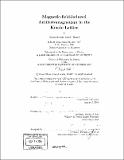Magnetic-field-induced antiferromagnetism in the Kondo lattice
Author(s)
Beach, Kevin S. D. (Kevin Stuart David), 1975-
DownloadFull printable version (5.469Mb)
Other Contributors
Massachusetts Institute of Technology. Dept. of Physics.
Advisor
Patrick A. Lee.
Terms of use
Metadata
Show full item recordAbstract
The half-filled Kondo lattice model, augmented by a Zeeman term, serves as a useful model of a Kondo insulator in an applied magnetic field. A variational mean field analysis of this system on a square lattice, backed up by quantum Monte Carlo calculations, reveals an interesting separation of magnetic field scales. For Zeeman energy comparable to the Kondo energy, the spin gap closes and the system develops transverse staggered magnetic order. The charge gap, however, remains robust up to a higher hybridization energy scale, at which point the canted antiferromagnetism is exponentially suppressed and the system crosses over to a nearly-metallic regime. The quantum Monte Carlo simulations are performed using a determinant Monte Carlo method that has been extended to handle mixed spin and fermionic degrees of freedom. The formulation is sign-problem-free for all values of the Kondo coupling and magnetic field strength. The matrix operations are specially organized to maintain numerical stability down to arbitrarily low temperatures. Spectral data is extracted from the imaginary-time correlation functions using an improved analytic continuation technique. The weak, secondary peaks of the single-electron spectral function are resolvable, and their response to the magnetic field is carefully tracked. An unusual rearrangement of spectral weight is found at the onset of the antiferromagnetism.
Description
Thesis (Ph. D.)--Massachusetts Institute of Technology, Dept. of Physics, 2004. Includes bibliographical references (p. 109-111).
Date issued
2004Department
Massachusetts Institute of Technology. Department of PhysicsPublisher
Massachusetts Institute of Technology
Keywords
Physics.